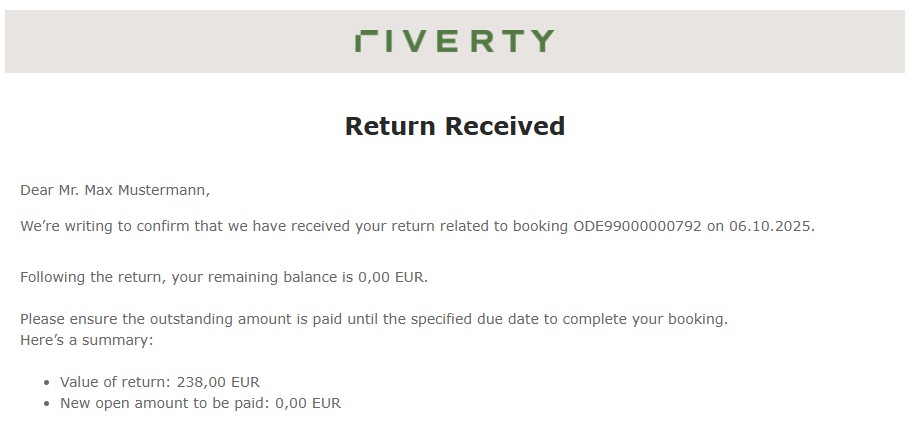Return Received Communication
Within Accounting as a Service, the Return Received Communication informs consumers automatically when a return has been successfully booked.
The return information is provided by the client via a return order interface. Once the posting of the return in Accounting as a Service is completed successfully, the consumer receives a confirmation message.
This proactive communication ensures transparency in the return process, keeps consumers informed about their financial status, and helps reduce customer service inquiries such as “Has my return been processed?” or “When will I get my refund?”
Sample

Key Benefits
Improved consumer experience
Consumers receive immediate confirmation that their returned items have been processed successfully — reducing “Where’s my refund?” inquiries.
Transparent financial communication
The message informs consumers about how the return has affected their account balance (e.g., cleared, open, or refundable).
Single, automated communication type
Each return booking triggers one automatic message — no manual steps required.
White-label flexibility
Templates are fully customizable, ensuring consistent brand communication across all consumer touchpoints.
Trigger and Logic
The communication is triggered automatically when a return has been successfully booked in Accounting as a Service.
The return data is provided through the client’s return order interface.
Suppression Rules
- Disabled if the consumer’s account has a collection flag.
- Disabled if the booking is older than 72 hours to avoid sending outdated information.
The message is only generated once the booking is complete and validated. Suppression rules ensure that communications remain relevant and accurate.
Dynamic Message Content
The Return Received Communication can display different contextual content depending on the result of the return booking:
- Account cleared: The return fully offsets outstanding amounts.
- Remaining open amount: There is still an amount due after the return.
- Refund pending: The return created a credit balance, and a refund will be initiated.
If a remaining open amount exists, an optional list of open positions can be displayed to provide more detailed information to the consumer.
Each client defines the wording and structure of these text blocks within their templates.
Templates can also include marketing content or call-to-action links (for example, directing the consumer to FAQs or new offers), which can be tracked for engagement analysis.
Customization Options
Clients can fully tailor the Return Received Communication to match their branding, tone, and business requirements.
Available customization options include:
- One template per language and company code (legal entity).
- Separate wordings possible for different regions (e.g., German vs. Austrian German).
- White-label design (colors, logos, and layout).
- Configurable text blocks for different account outcomes (cleared, remaining, refund).
- Optional marketing content or call-to-action links to support brand messaging.
- Templates optimized for display on both desktop and mobile devices.
Event specific parameters
Accounting as a Service provides a general list of parameters that are communicated for all consumer communications which are documented here.
The following parameters are provided by Accounting as a Service and can be used to personalize the Return Received Communication template.
Clients can decide which of these parameters to include in their message text or design.
- Total returned value: Value of the return that is booked
- Return number: External reference that should be known by the consumer as a reference
- Booking date: Date the return has been booked
- Invoice reference: Reference to the invoice, for which the return has been provided
- Order reference: Reference to the external order number, for which the return has been provided
- Payment method: Payment method that has been used, in the order. This information can be used to display to the consumer, where a refund will be issued.